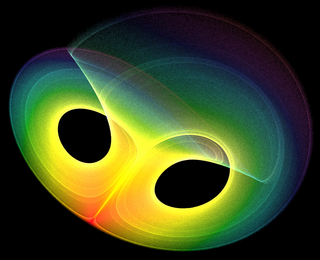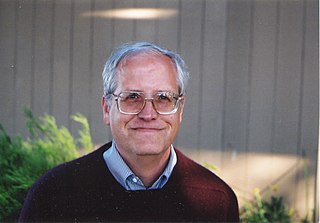
Analysis is the branch of mathematics dealing with continuous functions, limits, and related theories, such as differentiation, integration, measure, infinite sequences, series, and analytic functions.

Mathematical physics refers to the development of mathematical methods for application to problems in physics. The Journal of Mathematical Physics defines the field as "the application of mathematics to problems in physics and the development of mathematical methods suitable for such applications and for the formulation of physical theories". An alternative definition would also include those mathematics that are inspired by physics.

Lars Valter Hörmander was a Swedish mathematician who has been called "the foremost contributor to the modern theory of linear partial differential equations". Hörmander was awarded the Fields Medal in 1962 and the Wolf Prize in 1988. In 2006 he was awarded the Steele Prize for Mathematical Exposition for his four-volume textbook Analysis of Linear Partial Differential Operators, which is considered a foundational work on the subject.

Jürgen Kurt Moser was a German-American mathematician, honored for work spanning over four decades, including Hamiltonian dynamical systems and partial differential equations.

Ennio De Giorgi, a member of the House of Giorgi, was an Italian mathematician who worked on partial differential equations and the foundations of mathematics.

Hans Lewy was a Jewish American mathematician, known for his work on partial differential equations and on the theory of functions of several complex variables.
Hilbert's nineteenth problem is one of the 23 Hilbert problems, set out in a list compiled in 1900 by David Hilbert. It asks whether the solutions of regular problems in the calculus of variations are always analytic. Informally, and perhaps less directly, since Hilbert's concept of a "regular variational problem" identifies precisely a variational problem whose Euler–Lagrange equation is an elliptic partial differential equation with analytic coefficients, Hilbert's nineteenth problem, despite its seemingly technical statement, simply asks whether, in this class of partial differential equations, any solution function inherits the relatively simple and well understood structure from the solved equation. Hilbert's nineteenth problem was solved independently in the late 1950s by Ennio De Giorgi and John Forbes Nash, Jr.

Lawrence Craig Evans is an American mathematician and Professor of Mathematics at the University of California, Berkeley.

Fritz John was a German-born mathematician specialising in partial differential equations and ill-posed problems. His early work was on the Radon transform and he is remembered for John's equation. He was a 1984 MacArthur Fellow.

Guido Stampacchia was an Italian mathematician, known for his work on the theory of variational inequalities, the calculus of variation and the theory of elliptic partial differential equations.
In mathematics, Weyl's lemma, named after Hermann Weyl, states that every weak solution of Laplace's equation is a smooth solution. This contrasts with the wave equation, for example, which has weak solutions that are not smooth solutions. Weyl's lemma is a special case of elliptic or hypoelliptic regularity.
In mathematical analysis, a Young measure is a parameterized measure that is associated with certain subsequences of a given bounded sequence of measurable functions. They are a quantification of the oscillation effect of the sequence in the limit. Young measures have applications in the calculus of variations, especially models from material science, and the study of nonlinear partial differential equations, as well as in various optimization. They are named after Laurence Chisholm Young who invented them, already in 1937 in one dimension (curves) and later in higher dimensions in 1942.
Vladimir Gilelevich Maz'ya is a Russian-born Swedish mathematician, hailed as "one of the most distinguished analysts of our time" and as "an outstanding mathematician of worldwide reputation", who strongly influenced the development of mathematical analysis and the theory of partial differential equations.

Jean-François Le Gall is a French mathematician working in areas of probability theory such as Brownian motion, Lévy processes, superprocesses and their connections with partial differential equations, the Brownian snake, random trees, branching processes, stochastic coalescence and random planar maps. He received his Ph.D. in 1982 from Pierre and Marie Curie University under the supervision of Marc Yor. He is currently professor at the University of Paris-Sud in Orsay and is a senior member of the Institut universitaire de France. He was elected to French academy of sciences, December 2013.

Luigi Ambrosio is a professor at Scuola Normale Superiore in Pisa, Italy. His main fields of research are the calculus of variations and geometric measure theory.
Juan Luis Vázquez Suárez is Professor of Applied Mathematics at Universidad Autónoma de Madrid (UAM), Spain.

Paolo Marcellini is an Italian mathematician who deals with mathematical analysis. He is a full professor at the University of Florence. He is the Director of the Italian National Group GNAMPA of the Istituto Nazionale di Alta Matematica Francesco Severi (INdAM).
Donatella Danielli is a professor of mathematics at Arizona State University and is known for her contributions to partial differential equations, calculus of variations and geometric measure theory, with specific emphasis on free boundary problems.
Anthony Joseph Tromba is an American mathematician, specializing in partial differential equations, differential geometry, and the calculus of variations.
Mark H. Holmes is an American applied mathematician and Professor of Mathematics at Rensselaer Polytechnic Institute, where he served as Chair of the Department of Mathematical Sciences, and was the founding Director of the Center for Modeling, Optimization and Computational Analysis (MOCA).











